Acoelomate - Study guides, Class notes & Summaries
Looking for the best study guides, study notes and summaries about Acoelomate? On this page you'll find 50 study documents about Acoelomate.
Page 2 out of 50 results
Sort by
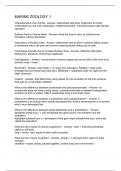
-
Marine Zoology #1
- Exam (elaborations) • 3 pages • 2024
-
- $9.99
- + learn more
Characteristics of an Animal - Answer- heterotroph (eat other organisms for food), multicellular (no cell wall, eukaryotic), motility/movement, *neurons/muscle cells (except sponges) Surface Area to Volume Ratio - Answer- limits the size of cells, as surface area increases volume decreases Importance of Surface Area - Answer- determines rate at which nutrients diffuse across a membrane into a cell and rate at which waste products diffuse out of cells Techniques Animals use to Increase S...
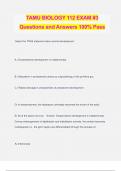
-
TAMU BIOLOGY 112 EXAM #3 Questions and Answers 100% Pass
- Exam (elaborations) • 33 pages • 2024
-
- $13.49
- + learn more
TAMU BIOLOGY 112 EXAM #3 Questions and Answers 100% Pass Select the TRUE statement about animal development: A.) Deuterostome development is indeterminate. B.) Mesoderm in protostomes arises as outpocketings of the primitive gut. C.) Radial cleavage is characteristic of protostome development. D) In deuterostomes, the blastopore ultimately becomes the mouth of the adult. E) All of the above are true. - Answer- Deuterostome development is indeterminate. During embryogenesis of diploblasti...
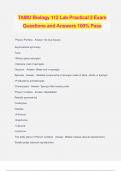
-
TAMU Biology 112 Lab Practical 2 Exam Questions and Answers 100% Pass
- Exam (elaborations) • 23 pages • 2024
-
- $12.49
- + learn more
TAMU Biology 112 Lab Practical 2 Exam Questions and Answers 100% Pass Phylum Porifera - Answer- No true tissues Asymmetrical symmetry Taxa: -Silicea (glass sponges) -Calcarea (rest of sponges) Osculum - Answer- Water exit in sponges Spicules - Answer- -Skeletal components of sponges made of silica, calcite or spongin -Produced by amoebocytes Choanocytes - Answer- Spong's filter-feeding cells Phylum Cnidaria - Answer- Diploblastic Radially symmetrical Cnidocytes Classes: -Anthozoa...
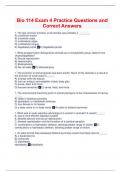
-
Bio 114 Exam 4 Practice Questions and Correct Answers
- Exam (elaborations) • 16 pages • 2024
-
Available in package deal
-
- $10.49
- + learn more
1. The last common ancestor of all animals was probably a ________. A) unicellular chytrid B) unicellular yeast C) multicellular algae D) multicellular fungus E) flagellated protist E) flagellated protist 1. What synapomorphy distinguishes animals as a monophyletic group, distinct from choanoflagellates? A) Sexual reproduction B) Heterotrophy C) Multicellularity D) No cell walls C) Multicellularity 1. The evolution of animal species has been prolific. Much of this diversity is a result of the ...

-
TEST BANK FOR Campbell Biology 9th Edition Glossary A+GRADED 2023.
- Exam (elaborations) • 138 pages • 2023
-
- $16.49
- + learn more
5′ cap - A modified form of guanine nucleotide added onto the 5′ end of a pre-mRNA molecule. A site - One of a ribosome's three binding sites for tRNA during translation. The A site holds the tRNA carrying the next amino acid to be added to the polypeptide chain. (A stands for aminoacyl tRNA.) ABC hypothesis - A model of flower formation identifying three classes of organ identity genes that direct formation of the four types of floral organs. abiotic - Nonliving; referring to th...

-
TEST BANK FOR Campbell Biology 9th Edition Glossary A
- Exam (elaborations) • 138 pages • 2023
-
- $23.99
- + learn more
TEST BANK FOR Campbell Biology 9th Edition Glossary A 5′ cap - A modified form of guanine nucleotide added onto the 5′ end of a pre-mRNA molecule. A site - One of a ribosome's three binding sites for tRNA during translation. The A site holds the tRNA carrying the next amino acid to be added to the polypeptide chain. (A stands for aminoacyl tRNA.) ABC hypothesis - A model of flower formation identifying three classes of organ identity genes that direct formation of the four types of f...
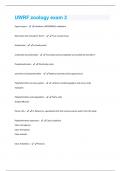
-
UWRF zoology exam 2 Questions Perfectly Answered!!
- Exam (elaborations) • 4 pages • 2024
- Available in package deal
-
- $7.99
- + learn more
3 germ layers - ectoderm, MESODERM, endoderm What does the mesoderm form? - True muscle tissue Acoelomate - no body cavity coelomate (eucoelomate) - True body cavity completely surrounded by mesoderm Pseudocoelomate - false body cavity symmetry of platyhelminthes - bilateral symmetry (first appearance) Platyhelminthes nervous system - -Anterior cerebral ganglion and nerve cords -Eyespots Platyhelminthes osmoregulation - Flame cells Simple diffusion Flame cells - In flatworms, specializ...
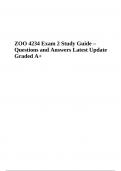
-
ZOO 4234 Exam 2 Study Guide – Questions and Answers Latest Update Graded A+
- Exam (elaborations) • 46 pages • 2023
- Available in package deal
-
- $15.49
- + learn more
ZOO 4234 Exam 2 Study Guide – Questions and Answers Latest Update Graded A+. Which of the following is a characteristic of Platyhelminthes? a) Most are parasitic b) Dorsoventrally flattened c) Triploblastic d) Acoelomate e) All of the above Which of the following is NOT a characteristic of Platyhelminthes? a) Triploblastic b) Parenchyma c) Pseudocoelomate d) Dorsoventrally flattened e) None of the above Which of the following is a class belonging to the Phylum Platyhelminthes? a) ...

-
Mastering Biology Questions and Answers Graded A
- Exam (elaborations) • 4 pages • 2023
- Available in package deal
-
- $8.49
- + learn more
Mastering Biology Questions and Answers Graded A Nematodes and arthropods are the largest ecdysozoan phyla. Which of the following statements are true? -Both nematodes and arthropods possess an external covering, or cuticle. -Nematodes possess a closed circulatory system. -Arthropods possess an open circulatory system. -Nematodes are acoelomate, whereas arthropods are coelomate. -Some nematodes are parasitic on humans. -Both nematodes and arthropods have segmented body plans. -Both nema...
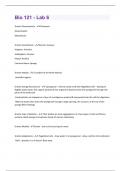
-
Bio 121 - Lab 6 exam (100% correct and graded A+)
- Exam (elaborations) • 6 pages • 2023
- Available in package deal
-
- $3.49
- + learn more
Grantia Characteristics - Eukaryotic Heterotrophic Multicellular Grantia Classification - Domain: Eukarya Kingdom: Animalia Subkingdom: Parazoa Phylum Porifera Common Name: Sponge Grantia Habitat - -Coastline of the North Atlantic -Intertidal regions Grantia Energy/Food Source - -Spongocoel - internal cavity lined with flagellated cells - beating of flagella draws water, fine organic particles & tiny organisms (bacteria) into the spongocoel through tiny pores of the body wall -Food ...

How much did you already spend on Stuvia? Imagine there are plenty more of you out there paying for study notes, but this time YOU are the seller. Ka-ching! Discover all about earning on Stuvia


